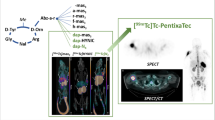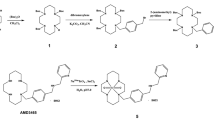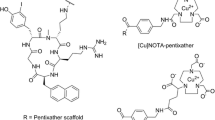Abstract
Purpose
CXCR4 is overexpressed on tumor cells from many types of human cancers. A high level of CXCR4 expression often correlates with poor prognosis, chemotherapy resistance, and metastasis. The development of CXCR4-specific radiotracers for positron emission tomography (PET) imaging will allow in vivo evaluation of receptor expression level for diagnosis or therapeutic evaluation.
Procedures
Two new 18F-labeled radiotracers based on an Ac-TC14012 peptide, [18F]FP-Ac-TC14012 and [18F]FB-Ac-TC14012, were synthesized and characterized. The affinities of the 2-fluoropropionate (FP)-conjugated or 4-fluorobenzoate (FB)-conjugated peptides to CXCR4-transfected Chinese hamster ovarian (CHO) cells were evaluated in a competitive binding assay with [125I]CXCL12 radioligand. The cell uptake and retention of [18F]FP-labeled and [18F]FB-labeled peptides were measured. The tumor targetability and pharmacokinetics of these two tracers were also evaluated by microPET imaging and biodistribution studies.
Results
The labeled peptides retained high binding affinity to CXCR4 and showed much higher uptake in CXCR4-positive CHO cells than in CXCR4-negative cells in vitro. The smaller and more hydrophilic [18F]FP prosthetic group resulted in higher affinity and lower nonspecific cell uptake compared to the [18F]FB-labeled peptide. Both radiotracers showed much higher accumulation in CXCR4-positive than CXCR4-negative tumor xenografts in mice and allowed clear visualization of CXCR4 expression by PET. Among the two, [18F]FP-Ac-TC14012 showed higher tumor uptake and better tumor-to-background contrast. Unlike their N-terminal 4-F-benzoate analogs, these two tracers had minimal blood retention, likely due to reduced red blood cell binding. Metabolic organs, such as the liver and kidney, also showed high uptake. When blocked with low-dose cold peptide (10 μg), the tumor uptake was significantly increased, most likely due to the increased concentration in blood circulation, as evidenced by decreased liver uptake.
Conclusion
These results demonstrate that the [18F]FP-labeled Ac-TC14012 peptide with high tumor uptake, low nonspecific binding, and good tumor-to-background contrast promises [18F]FP-Ac-TC14012 as a PET tracer for in vivo PET imaging of CXCR4 expression.






Similar content being viewed by others
References
Balkwill F (2004) The significance of cancer cell expression of the chemokine receptor CXCR4. Semin Cancer Biol 14:171–179
Zhou Y, Larsen PH, Hao C, Yong VW (2002) CXCR4 is a major chemokine receptor on glioma cells and mediates their survival. J Biol Chem 277:49481–49487
Corcione A, Ottonello L, Tortolina G et al (2000) Stromal cell-derived factor-1 as a chemoattractant for follicular center lymphoma B cells. J Natl Cancer Inst 92:628–635
Koshiba T, Hosotani R, Miyamoto Y et al (2000) Expression of stromal cell-derived factor 1 and CXCR4 ligand receptor system in pancreatic cancer: a possible role for tumor progression. Clin Cancer Res 6:3530–3535
Scotton CJ, Wilson JL, Scott K et al (2002) Multiple actions of the chemokine CXCL12 on epithelial tumor cells in human ovarian cancer. Cancer Res 62:5930–5938
Hwang JH, Hwang JH, Chung HK et al (2003) CXC chemokine receptor 4 expression and function in human anaplastic thyroid cancer cells. J Clin Endocrinol Metab 88:408–416
Muller A, Homey B, Soto H et al (2001) Involvement of chemokine receptors in breast cancer metastasis. Nature 410:50–56
Geminder H, Sagi-Assif O, Goldberg L et al (2001) A possible role for CXCR4 and its ligand, the CXC chemokine stromal cell-derived factor-1, in the development of bone marrow metastases in neuroblastoma. J Immunol 167:4747–4757
Wald O, Shapira OM, Izhar U (2013) CXCR4/CXCL12 axis in non-small cell lung cancer (NSCLC) pathologic roles and therapeutic potential. Theranostics 3:26–33
Werner L, Guzner-Gur H, Dotan I (2013) Involvement of CXCR4/CXCR7/CXCL12 interactions in inflammatory bowel disease. Theranostics 3:40–46
Ratajczak MZ, Serwin K, Schneider G (2013) Innate immunity derived factors as external modulators of the CXCL12–CXCR4 axis and their role in stem cell homing and mobilization. Theranostics 3:3–10
Katsumoto K, Kume S (2013) The role of CXCL12–CXCR4 signaling pathway in pancreatic development. Theranostics 3:11–17
Staller P, Sulitkova J, Lisztwan J, Moch H, Oakeley EJ, Krek W (2003) Chemokine receptor CXCR4 downregulated by von Hippel–Lindau tumour suppressor pVHL. Nature 425:307–311
Helbig G, Christopherson KW, Bhat-Nakshatri P et al (2003) NF-κ B promotes breast cancer cell migration and metastasis by inducing the expression of the chemokine receptor CXCR4. J Biol Chem 278:21631–21638
Azab AK, Runnels JM, Pitsillides C et al (2009) CXCR4 inhibitor AMD3100 disrupts the interaction of multiple myeloma cells with the bone marrow microenvironment and enhances their sensitivity to therapy. Blood 113:4341–4351
Kurtova AV, Tamayo AT, Ford RJ, Burger JA (2009) Mantle cell lymphoma cells express high levels of CXCR4, CXCR5, and VLA-4 (CD49d): importance for interactions with the stromal microenvironment and specific targeting. Blood 113:4604–4613
Peled A, Tavor S (2013) Role of CXCR4 in the pathogenesis of acute myeloid leukemia. Theranostics 3:34–39
Zhang S, Qi L, Li M et al (2008) Chemokine CXCL12 and its receptor CXCR4 expression are associated with perineural invasion of prostate cancer. J Exp Clin Cancer Res 27:62
Yoon Y, Liang Z, Zhang X et al (2007) CXC chemokine receptor-4 antagonist blocks both growth of primary tumor and metastasis of head and neck cancer in xenograft mouse models. Cancer Res 67:7518–7524
Weiss I, Jacobson O, Kiesewetter D et al (2012) Positron emission tomography imaging of tumors expressing the human chemokine receptor CXCR4 in mice with the use of 64Cu-AMD3100. Mol Imaging Biol 14:106–114
De Silva RA, Peyre K, Pullambhatla M, Fox JJ, Pomper MG, Nimmagadda S (2011) Imaging CXCR4 expression in human cancer xenografts: evaluation of monocyclam 64Cu-AMD3465. J Nucl Med 52:986–993
Jacobson O, Weiss ID, Szajek L, Farber JM, Kiesewetter DO (2009) 64Cu-AMD3100—a novel imaging agent for targeting chemokine receptor CXCR4. Biorg Med Chem 17:1486–1493
Nimmagadda S, Pullambhatla M, Stone K, Green G, Bhujwalla ZM, Pomper MG (2010) Molecular imaging of CXCR4 receptor expression in human cancer xenografts with [64Cu]AMD3100 positron emission tomography. Cancer Res 70:3935–3944
Hennrich U, Seyler L, Schäfer M et al (2012) Synthesis and in vitro evaluation of 68Ga-DOTA-4-FBn-TN14003, a novel tracer for the imaging of CXCR4 expression. Bioorg Med Chem 20:1502–1510
Jacobson O, Weiss ID, Kiesewetter DO, Farber JM, Chen X (2010) PET of tumor CXCR4 expression with 4-18F-T140. J Nucl Med 51:1796–1804
Jacobson OWI, Szajek LP, Niu G, Ma Y, Kiesewetter DO, Farber JM, Chen X (2011) PET imaging of CXCR4 using copper-64 labeled peptide antagonist. Theranostics 1:251–262
Jacobson O, Weiss ID, Szajek LP et al (2012) Improvement of CXCR4 tracer specificity for PET imaging. J Control Release 157:216–223
Demmer O, Gourni E, Schumacher U, Kessler H, Wester H-J (2011) PET Imaging of CXCR4 receptors in cancer by a new optimized ligand. ChemMedChem 6:1789–1791
Demmer O, Dijkgraaf I, Schumacher U et al (2011) Design, synthesis, and functionalization of dimeric peptides targeting chemokine receptor CXCR4. J Med Chem 54:7648–7662
Tamamura H, Omagari A, Oishi S et al (2000) Pharmacophore identification of a specific CXCR4 inhibitor, T140, leads to development of effective anti-HIV agents with very high selectivity indexes. Bioorg Med Chem Lett 10:2633–2637
Tamamura H, Omagari A, Hiramatsu K et al (2001) Development of specific CXCR4 inhibitors possessing high selectivity indexes as well as complete stability in serum based on an anti-HIV peptide T140. Bioorg Med Chem Lett 11:1897–1902
Tamamura H, Hiramatsu K, Mizumoto M et al (2003) Enhancement of the T140-based pharmacophores leads to the development of more potent and bio-stable CXCR4 antagonists. Org Biomol Chem 1:3663–3669
Tamamura H, Hiramatsu K, Kusano S et al (2003) Synthesis of potent CXCR4 inhibitors possessing low cytotoxicity and improved biostability based on T140 derivatives. Org Biomol Chem 1:3656–3662
Lang L, Li W, Guo N et al (2011) Comparison study of [18F]FAl-NOTA-PRGD2, [18F]FPPRGD2, and [68Ga]Ga-NOTA-PRGD2 for PET imaging of U87MG tumors in mice. Bioconjug Chem 22:2415–2422
Kiesewetter DO, Jacobson O, Lang L, Chen X (2011) Automated radiochemical synthesis of [18F]FBEM: a thiol reactive synthon for radiofluorination of peptides and proteins. Appl Radiat Isot 69:410–414
Wong ML, Xin WW, Duman RS (1996) Rat LCR1: cloning and cellular distribution of a putative chemokine receptor in brain. Mol Psychiatr 1:133–140
Lazarini F, Casanova P, Tham TN et al (2000) Differential signalling of the chemokine receptor CXCR4 by stromal cell-derived factor 1 and the HIV glycoprotein in rat neurons and astrocytes. Eur J Neurosci 12:117–125
Lavi E, Strizki JM, Ulrich AM et al (1997) CXCR-4 (fusin), a co-receptor for the type 1 human immunodeficiency virus (HIV-1), is expressed in the human brain in a variety of cell types, including microglia and neurons. Am J Pathol 151:1035–1042
Kuil J, Buckle T, Yuan H et al (2011) Synthesis and evaluation of a bimodal CXCR4 antagonistic peptide. Bioconjug Chem 22:859–864
Moepps B, Frodl R, Rodewald H-R, Baggiolini M, Gierschik P (1997) Two murine homologues of the human chemokine receptor CXCR4 mediating stromal cell-derived factor 1α activation of Gi2 are differentially expressed in vivo. Eur J Immunol 27:2102–2112
Hanaoka H, Mukai T, Tamamura H et al (2006) Development of a 111In-labeled peptide derivative targeting a chemokine receptor, CXCR4, for imaging tumors. Nucl Med Biol 33:489–494
Acknowledgments
We want to thank the Intramural Research Program of the National Institute of Biomedical Imaging and Bioengineering (NIBIB), National Institutes of Health (NIH) for the funding support. This work was performed while X-X Zhang held a National Research Council Research Associateship Award at NIH/NIBIB.
Conflict of Interest
The authors declare that they have no conflict of interest.
Author information
Authors and Affiliations
Corresponding authors
Electronic supplementary materials
Below is the link to the electronic supplementary material.
ESM 1
(PDF 205 kb)
Rights and permissions
About this article
Cite this article
Zhang, XX., Sun, Z., Guo, J. et al. Comparison of 18F-labeled CXCR4 antagonist peptides for PET imaging of CXCR4 expression. Mol Imaging Biol 15, 758–767 (2013). https://doi.org/10.1007/s11307-013-0640-0
Published:
Issue Date:
DOI: https://doi.org/10.1007/s11307-013-0640-0




